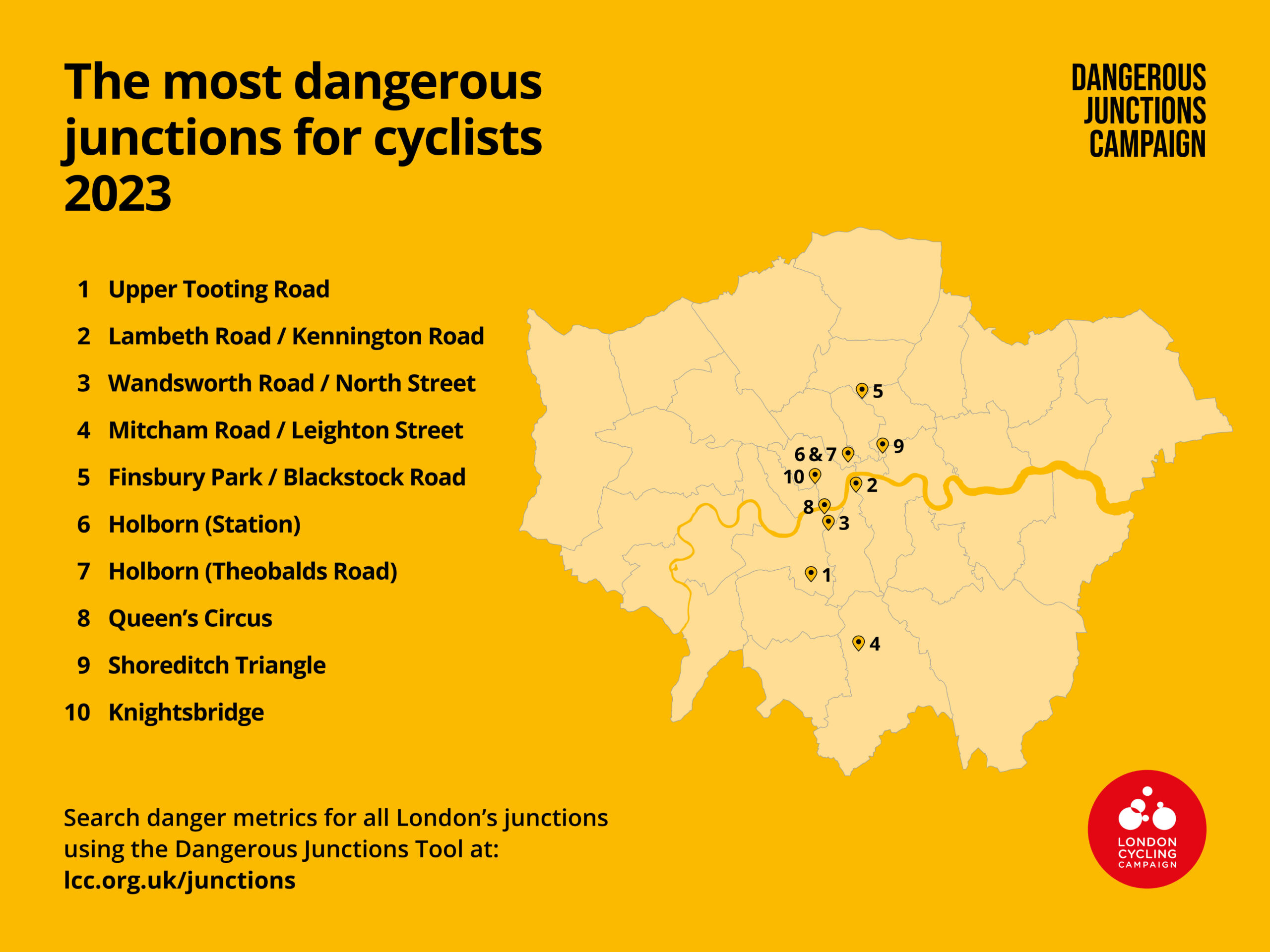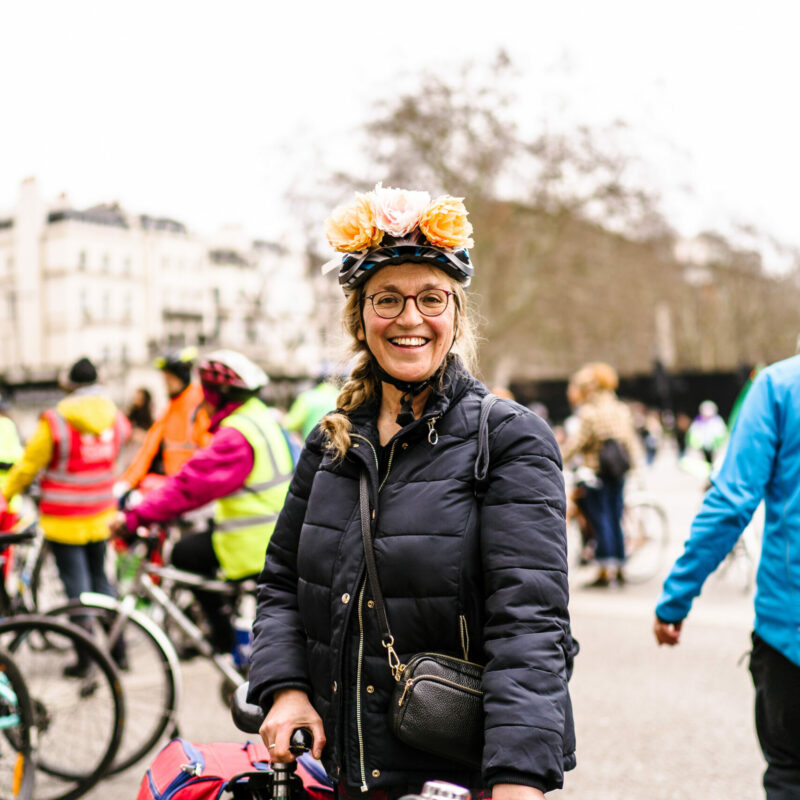Fix the junctions
London’s junctions are where the majority of serious and fatal collisions occur for those cycling and walking.
Safer junction design has long been understood to be one of the key methods of not only reducing road danger but also enabling more people to walk and cycle safely. That’s why we launched our Dangerous Junctions campaign in 2022 following the deaths of Dr Marta Krawiec and Shatha Ali at Holborn, both killed while cycling through notoriously dangerous junctions.
Yet London’s boroughs, Mayor and Transport for London have been shamefully slow and partial in dealing with this key road danger. The Mayor’s ‘Safer Junctions’ programme is moving too slowly and its designs are too weak – leaving in ‘critical issues’ (by its own assessment) at too many junctions.
We’re today calling on the Mayor, Transport for London and London councils to move faster, be bolder and fix these dangerous junctions to avoid needless, predictable deaths.
Quotes from the press launch
“Behind this horrific data are hundreds of stories of families torn apart by tragedy and lives changed forever. The Mayor has committed to a ‘Vision Zero’ for London by 2041 – but that would mean over 17 years more fatal and serious collisions for Londoners – we need to be faster and bolder. Whilst cycling and indeed walking and wheeling remain relatively safe, healthy ways of getting about London, TfL, the Mayor and our boroughs must move faster and be bolder on road danger to stem the human cost posed by dangerous junctions and poor road designs,” Tom Fyans, Chief Executive, London Cycling Campaign.
“Years of inaction on road danger and cycling means it is sadly unsurprising that Wandsworth not only has the most dangerous junction for cycling in its bounds, but two junctions in the top 10. Both could and should have seen action by now. We’ve known for years that the ratruns that intersect Cycle SuperHighway CS7 need tackling, most effectively by creating Low Traffic Neighbourhoods on either side; that far from being ‘revolutionary’, Queen’s Circus falls far below modern cycling design standards; and that our Council prioritises driving convenience over the physical safety of its residents. We urge the Council to now take road danger at its junctions seriously – to stem the ongoing tide of serious and fatal collisions on its roads,” Celia Duncan, Coordinator, Wandsworth Cycling Campaign.
“This mapping shows the horrific impact not only to those cycling, but also to pedestrians, from dangerous junctions across the whole of London. Almost 4,000 people were killed or seriously injured on London’s roads last year and well over half of those were either walking or cycling. This is simply an unacceptable level of loss and road danger that people walking and cycling face. London must take bolder steps to make these junctions safe for those on foot too. The actions needed are well known and include pedestrian phases on all arms of crossings, enough time to cross, no more than a 30 second wait and crossings in the places that pedestrians need them,” Jeremy Leach, Chair, London Living Streets
“The Tooting section of the CS7 Cycle Superhighway is the most popular cycle route used by St. George’s Hospital staff according to the hospital’s Bicycle Users Group survey. However, that survey also reports of the serious dangers in using CS7. The dangers listed include: the lack of maintenance of CS7; cars pulling out across CS7 at junctions; the lack of enforcement of illegal car parking; the absence of/damage to cycle wands; and illegal turns by cars into ‘no left turns’ junctions. These problems make cycling to work by staff from St. George’s Hospital an unnecessarily risky mode of active travel. Improvements along that section are urgently needed to reduce the number of collisions,” Dr Cleo Kenington, Consultant Surgeon, Co-Chair Bicycle Users Group, St Georges Hospital, Tooting
What’s going wrong with junctions in London?
In London, junctions designed from the 1970s onwards are nearly always designed primarily for motor traffic capacity.
When you’re walking:
- You can wait minutes for a green signal if one even exists. Many junctions in London with traffic lights still have multiple ‘arms’ where there’s no pedestrian signal – it’s run across and hope. In reality, the vast majority of people cross a signalised crossing within 30 seconds of arriving at it. So if you’re asking pedestrians to wait a minute or more for a green, most will cross on red.
When you’re cycling:
- Junctions until circa 2010 mostly mixed cyclists with motor traffic, leading to the ‘left hook’ risk – where someone is cycling ahead, and a driver turning left across the person cycling. Over time, the Advanced Stop Line (ASL) or ‘bike box’ was put in at an increasing number of junctions to provide space for cyclists to get in front of traffic. Except ASLs only work if you cycle up on a red light, and smaller ASLs can even put those cycling right into the blind spot of larger vehicles with restricted driver view, such as tipper trucks.
- Since circa 2010, ‘early release’ lights that give people cycling a few seconds head start on traffic have become more common. But these still only work if you turn up on a red, and they aren’t sufficient to enable more people to cycle – just mildly improve safety for those who already cycle. No one’s going to ride with their kids through a junction that gives you four seconds head-start on the tipper lorry behind you.
- Proper ‘separation in time and/or space’ is found at far too few major London junctions. Transport for London tends to favour ‘hold the left’ junctions where left-turning motor traffic is held on a red while people cycling get a green, then vice versa. But these junctions need lots of space generally and can impact motor traffic including buses heavily. What’s puzzling here is that there are other options – but Transport for London seems stuck not rolling them out. See our Dangerous Junctions report (also available on our main junctions campaign page) for how Transport for London and boroughs could and should accelerate safety gains at junctions.
What’s TfL getting wrong?
London can do major junction upgrades, fast when it wants to, and well. But it seems to be stuck failing to do either. When Dr Marta Krawiec was killed at the notorious Theobalds Road/Southampton Row Holborn junction in 2021, TfL and Camden Council used temporary materials to ‘fix’ the issues at the arm of the junction where she died within weeks; within months, a permanent change was being consulted on and implemented.
In other locations too, usually spurred by an LCC protest and campaigning, trial changes have been rapidly implemented. So if we shout loud enough and enough people die, TfL it seems can get a shift on – but it clearly should not be a case of TfL prizing motor traffic movement and Bus journey times above lives until the noise gets too much for them. Instead, we want TfL to assess every junction where there’s a serious or fatal collision for changes needed and act within weeks.
We also want TfL to assess and roll out far quicker bold measures that have been delivered in isolation in London and which are proven to work – instead, the organisation seems locked into incoherence and internal siloed working. The Mayor has demanded rapid and bold reductions in motor traffic to achieve both his Transport Strategy and Net Zero targets, and in the Transport Strategy there’s also a commitment to ‘Vision Zero’ – an end to serious and fatal collisions, currently set for 2041. We think that needs accelerating to enable a lot more people to ditch the car and cycle instead. But also because if it isn’t accelerated that could well mean over a hundred more cycling fatalities from now until 2041 and over 15,000 serious collisions (and the same again for pedestrians). Every one of those means a heavy toll for friendship circles, families and life-changing injuries for victims.
We have seen TfL and London boroughs roll out several key rapid and relatively cheap solutions to road danger at junctions in isolation – Waltham Forest has delivered around eight ‘Circulating Cycle Stage’ junctions since 2014, and has another three about to go into construction. These DfT-approved junction designs are also known as CYCLOPS junctions in Manchester and demonstrably can be delivered with massive safety gains for pedestrians and those cycling, while not impacting motor traffic or buses heavily. Yet only Waltham Forest in London has delivered these.
Similarly, ‘cycle gate’ and ‘bus gate’ schemes can be rolled out cheaply and rapidly and the latter also means dramatic gains for bus journey times. But there’s no sign that TfL and borough delivery of the latter has been championed by TfL Buses itself, and the former has only been done again when campaigning pressure has been heavily applied following collisions.
Indeed, TfL and the Mayor’s ‘Safer Junctions’ programme, which amounts to the response to the ongoing clear road danger issues with too many junctions in London, has focused solely on smaller junctions, on roads only that TfL controls (‘TLRN’ or ‘red route’ roads) and even then, and even prior to the pandemic when funding for junctions was more available, many of the designs advanced included ‘critical issues’ – these are the objective things TfL mandates itself and boroughs to avoid in order to avoid road danger issues. Since the pandemic, junction delivery has nearly totally collapsed in part due to funding – but clearly in part due to internal pushback against any impacts to motor traffic and buses.
Last year in 2022, we produced a report based on a summit we held with the UK’s top engineers, designers, modellers and planners – experts on junction design. The report highlighted Transport for London’s internal incoherence as a major issue. Over a year and multiple fatalities later, it feels as if TfL and London have gone backwards, not forwards, on this issue. We beg the Mayor of London not to let another year slip by with TfL prioritising motor traffic and buses far above lives.








